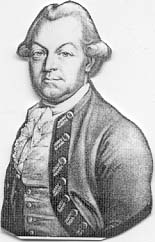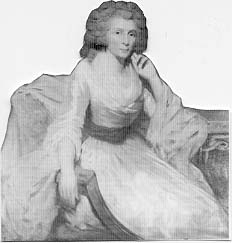 This
story is about a mysterious woman and the sleuth who proved that you
should not believe everything you read. Although Brigadier General Simon
Fraser of Balnain was a reasonably well known British army officer during
the American Revolution, little information was available about his
personal life, so I turned to the Toronto Reference Library. Imagine my
surprise when I found a photo of Brig-General Simon Fraser (1729-77) who
died at Saratoga [from the William C. Clements Library, University of
Michigan] in The McGraw-Hill Encyclopedia of World History (1973),
incorrectly identified as Simon Fraser (1776-1862), the explorer and fur
trader, of the Culbokie family, who was born near Bennington, now in
Vermont. According to the Dictionary of National Biography, the
Simon Fraser who died at Saratoga had, in 1769, married Mrs. Grant of
Percy Street, London, ‘and by this lady had issue’.
This
story is about a mysterious woman and the sleuth who proved that you
should not believe everything you read. Although Brigadier General Simon
Fraser of Balnain was a reasonably well known British army officer during
the American Revolution, little information was available about his
personal life, so I turned to the Toronto Reference Library. Imagine my
surprise when I found a photo of Brig-General Simon Fraser (1729-77) who
died at Saratoga [from the William C. Clements Library, University of
Michigan] in The McGraw-Hill Encyclopedia of World History (1973),
incorrectly identified as Simon Fraser (1776-1862), the explorer and fur
trader, of the Culbokie family, who was born near Bennington, now in
Vermont. According to the Dictionary of National Biography, the
Simon Fraser who died at Saratoga had, in 1769, married Mrs. Grant of
Percy Street, London, ‘and by this lady had issue’.
I next turned to my dear friend in Scotland, Colonel
James Fraser, M.C. (1921-99), a descendant of Simon’s older brother, Dr.
Thomas Fraser (1726-60), of Antigua. Colonel James could find no record
among his family papers of Simon having had any children, legitimate or
otherwise, but he suggested I get in touch with Randolph Vigne, a distant
cousin in London. He remembered having heard that this lady had married
three times ‘first for money, second for gallantry, and thirdly for love’.
Randolph Vigne, a South African by birth, was
fascinated to discover that Margarita Hendrika was the daughter of a
prosperous merchant at the Cape of Good Hope, named Johan Zacharias Beck
of Langesalza, north of Gotha, Germany, who had come there first in 1715
as a soldier in the service of the Dutch East India Company and had been
allowed to stay on as a burgher of the place. In England, Margarita was
reported to have been a ‘relative of Colonel von Prahn’ [Hendrik Prehn],
the Dutch Commandant at the Cape, which is doubtful.
She married first, at the Cape, circa 1765, Major
Alexander Grant of Shewglie, who had fled Scotland after the defeat of
Prince Charles Edward Stuart’s forces at Culloden in 1746 and wound up as
an officer with the British forces in India. Grant was among the group in
Calcutta in 1756 who escaped by boat with the Governor, leaving the
civilians to suffer the horrors of the Black Hole. He was pardoned for his
act partly because of a pamphlet he published blaming the Governor, and
partly for being one of the officers who persuaded Clive to attack at
Plassey, which ensured Britain’s dominance in India. Alexander Grant died
during a trip to India in 1768, at the age of 43, and left the fortune he
had acquired as an East India merchant in London to his ‘beloved wife
Margaretta Henrietta Grant’, as sole executrix. His only other bequest was
to cancel a £200 debt owed by his brother, Patrick Grant of Lochletter.
On 14 Oct 1769, Mrs. Grant of Percy Street, London,
married, as her second husband, Simon Fraser who, on his death at Saratoga
in October 1777, left everything to ‘my loving wife Margaretta Henrietta
Fraser’, who was her own executrix. Randolph Vigne advises that the will
was made 13 Nov 1769, and Simon would certainly have altered it if a child
had been born before his departure for the American War. According to
Colonel James Fraser, two celebrated paintings by John Graham, depicting
General Fraser’s death, were presented to his widow.
There was a novel trial in which this lady was a party,
extracted from the London Chronicle for July 4-6, 1780, vol. 48, p.
10:
"Yesterday [July 31], was tried before the Right Hon.
Earl Mansfield and a special jury, a case wherein Mr. Schreiber, a
merchant, was plaintiff, and Mrs. Frazer, widow of the late Gen. Frazer,
was defendant. The action was brought for damages on a breach of promise
of marriage…" Evidently, the lawyer for the defendant tried to convince
the jury that she was a poor widow but the lawyer for the plaintiff, Mr.
Dunning, "adduced proof that the Lady’s fortune here, in the East Indies,
and America, amounted to £24,000 upwards… The jury, after a consultation
of a few minutes, gave a verdict of £600 damages, with costs."
She married thirdly, in 1781, as his second wife,
George Buchan-Hepburn of Smeaton, a 42 year-old Edinburgh lawyer who
became Baron of the Exchequer and a Baronet. She was nearing her
mid-thirties when she at last married for love. He did not need the
fortune she brought with her as he had already achieved success at the
bar, so one hopes he married her for love too. Sir George died in 1815.
 Randolph
Vigne wrote a brief account of her in a South African literary review [Capetown,
December 1994].
Randolph
Vigne wrote a brief account of her in a South African literary review [Capetown,
December 1994].
"At last I have seen her picture, painted by Raeburn -
and what a let-down! The bewitching Margarita of the respectively, rich,
gallant and romantic husbands, turns out to have had the most remarkably
homely features, which even Raeburn could not muffle in diaphanous
drapery."
She died 16 Nov 1823, probably in her 70s, and is
buried in the family vault at Prestonkirk, East Lothian, as is Sir
Buchan-Hepburn’s first wife, through whom the line continues. Margarita
had no children of her own.
In 1995 the Raeburn portrait of Margarita, when Lady
Buchan-Hepburn, painted in her later life, was still in the estate of the
late Sir Ninian Buchan-Hepburn, but the executors allowed it to be
photographed with the consent of the 7th Baronet, Sir Alastair
Buchan-Hepburn, with whom Randolph Vigne was corresponding.
After my husband and I sat down to dinner inside the
large marquee set up on the grounds of Castle Fraser during the Clan
Fraser Gathering held there in August 1997, imagine my surprise when
someone’s hands covered my eyes from behind and whispered, "For Money,
Gallantry and Love". It was Randolph Vigne, back from South Africa.
I appreciate how confusing it can be to identify the
various officers named Simon Fraser who served in British regiments during
the Seven Years War (1757-63) and the American Revolution (1775-83).
However, it still came as a surprise last year, to learn from a reliable
source in Canada, about an acquaintance named Fraser, living in the United
States, who claimed to be descended from the Simon Fraser who had been at
Bergen-Op-Zoom (1747) and the battle of the Plains of Abraham (1759), and
died as a brigadier general at Saratoga (1777). No further information has
been received from the claimant about his alleged 8x great grandfather.
